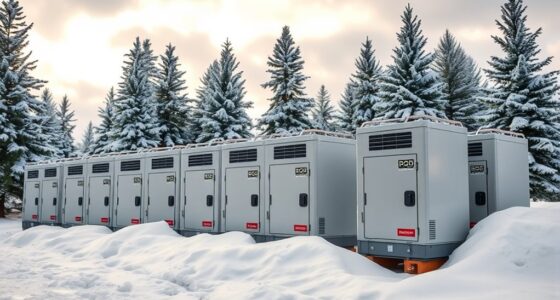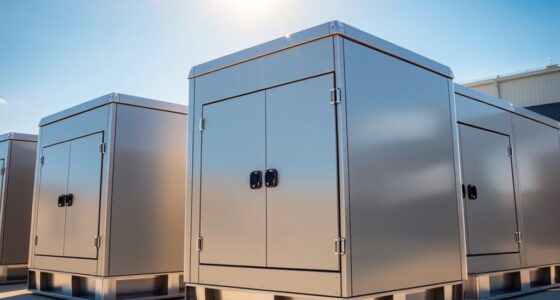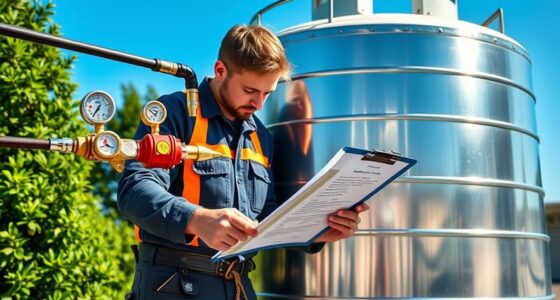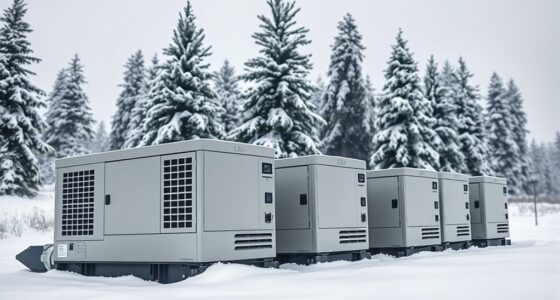When sizing a propane tank for your standby generator, it’s essential to assess your power needs, factoring in peak loads and expected runtimes, rather than relying on larger tanks alone. Misconceptions like bigger tanks always providing longer support can lead to oversizing, which may cause safety and filling issues. Instead, focus on your generator’s fuel efficiency, safety regulations, and space constraints. Keep in mind, proper planning guarantees safe, reliable power—learn more about making the right choice.
Key Takeaways
- Proper tank sizing depends on generator fuel efficiency, load demands, and expected runtimes, not just tank volume.
- Larger tanks don’t necessarily mean longer outage support; safe fill levels and vapor space are crucial.
- Follow safety regulations and local codes for placement, size limits, and venting to ensure safe operation.
- Assess environmental factors and site conditions to optimize tank size, accessibility, and safety measures.
- Regular maintenance, inspections, and proper installation are essential for the reliability and safety of propane backup systems.
Understanding Your Power Needs and Consumption Rates
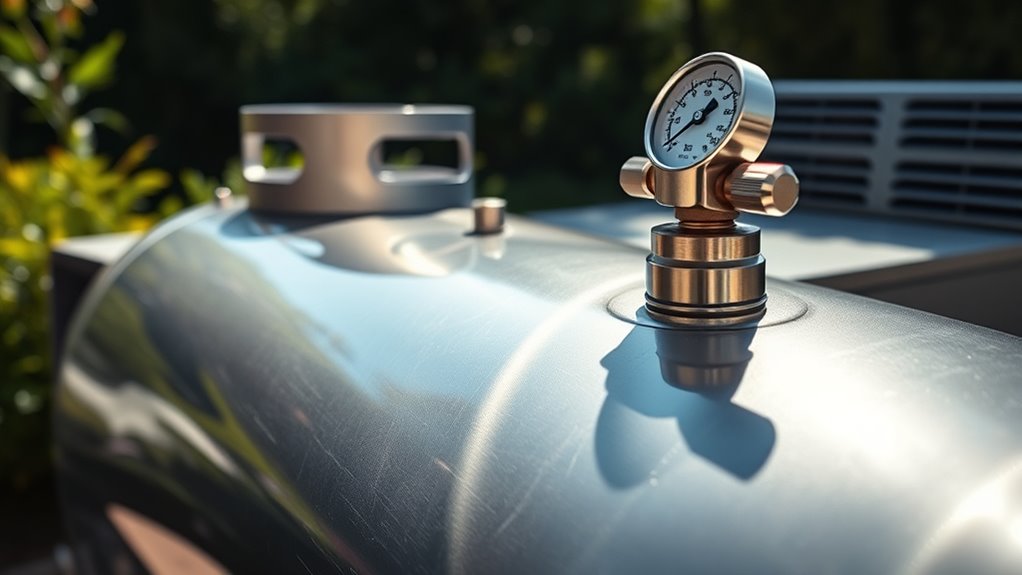
To determine the right propane tank size for your standby generator, you first need to understand your power needs and how much fuel your generator consumes. Conduct a load evaluation to identify the total wattage your generator must support during outages. This helps you estimate fuel consumption based on your generator’s fuel efficiency, which varies with load. Higher loads typically reduce fuel efficiency, increasing consumption rates. Knowing your peak power requirements ensures you select a tank that can supply enough fuel for extended operation, especially during long outages. By accurately evaluating your load and understanding your generator’s fuel efficiency, you can choose a tank size that provides reliable backup power without overpaying for excess capacity. Proper planning ensures your generator runs smoothly when you need it most. Additionally, considering heat pump efficiency ratings can help optimize your overall energy management and reduce operational costs during backup power scenarios.
Common Misconceptions About Tank Sizes and Capacity
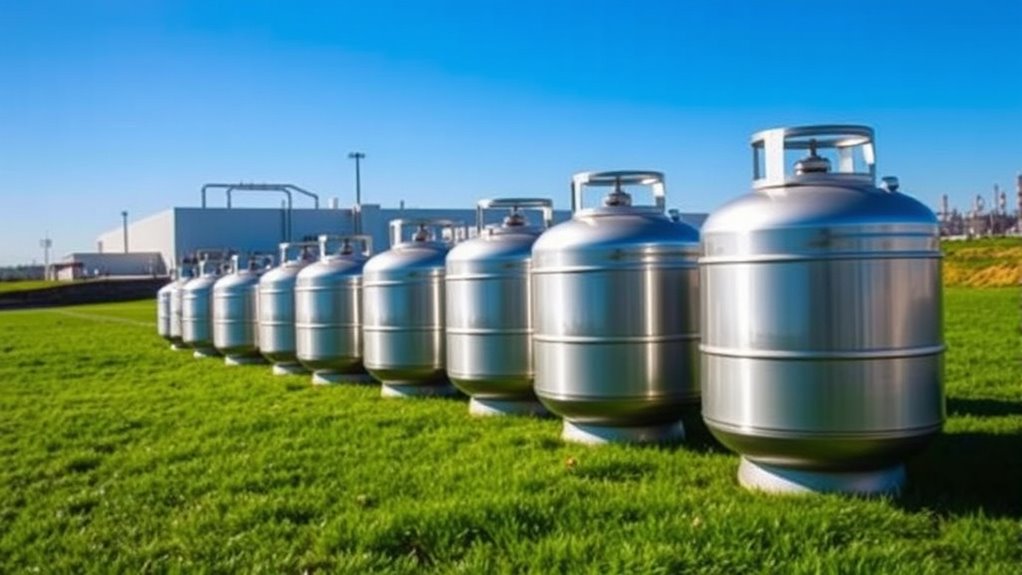
Many people assume that choosing a larger propane tank automatically means they’ll have enough fuel to last through any outage. However, tank size alone isn’t the full story. The tank’s height impacts how much fuel it can hold, but it also affects the fill level you can safely maintain. A taller tank with the same capacity as a shorter one might be more difficult to fill completely due to safety regulations and vapor space. Additionally, having a larger tank doesn’t guarantee you’ll use all that fuel before it expires or vaporizes. It’s essential to understand that effective tank capacity depends on proper fill levels and your generator’s consumption rate. Proper sizing ensures your generator has a reliable fuel source during outages, and ventilation requirements can influence how much fuel you can safely store. Bigger isn’t always better; proper sizing and fill management make the real difference.
Key Factors Influencing Propane Tank Sizing

Several critical factors influence how you should size a propane tank for your standby generator. First, your generator’s fuel efficiency determines how much propane it consumes during operation. Second, safety regulations dictate minimum and maximum tank sizes, ensuring safe storage. Third, your expected runtime impacts tank size; longer outages require larger tanks. Fourth, local building codes may impose restrictions affecting tank placement and capacity. Additionally, understanding beach destinations can help in planning your overall setup if your property is near such scenic areas. Use this table for clarity:
| Factor | Impact | Consideration |
|---|---|---|
| Fuel Efficiency | Determines fuel consumption rate | Choose based on generator specifications |
| Safety Regulations | Set legal size limits | Comply with local codes |
| Runtime Needs | Influences tank capacity | Larger tanks for extended outages |
Understanding these factors helps you select a safe, efficient tank size tailored to your needs.
Practical Tips for Selecting the Right Tank Size
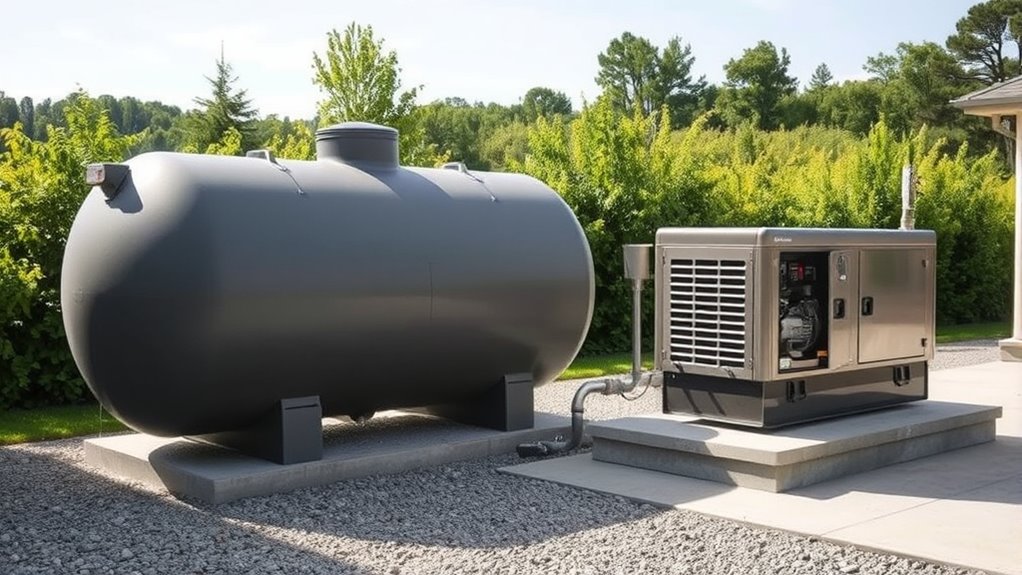
Choosing the right propane tank size involves balancing your generator’s fuel needs with practical considerations. First, assess your generator’s expected runtime during outages, then add extra capacity for safety and future expansion. Keep in mind that tank insulation can help maintain propane’s temperature, especially in colder climates, reducing the risk of fuel issues. Always follow safety regulations regarding tank placement, clearances, and venting to prevent hazards. Consider the space available on your property and how accessible the tank will be for refilling and maintenance. Larger tanks offer longer backup times but may require more substantial installation efforts. Ultimately, selecting a tank size that aligns with your power needs, safety standards, and site conditions ensures reliable performance and peace of mind.
Avoiding Pitfalls and Ensuring Long-Term Reliability

To guarantee your standby generator remains reliable over time, it’s vital to avoid common pitfalls that can compromise performance. Prioritize tank safety by ensuring proper installation and regular inspections to prevent leaks or corrosion. A neglected tank can pose environmental risks, so choose a reputable supplier and adhere to safety standards. Overfilling or improper venting can lead to hazardous situations, so follow manufacturer guidelines carefully. Also, consider the environmental impact of your propane storage; opting for environmentally friendly practices and preventing spills helps protect your surroundings. Proper filtration systems, including regular maintenance of the tank’s components, are essential for optimal safety and efficiency. Regular maintenance not only enhances reliability but also extends your tank’s lifespan. By addressing these aspects, you ensure your system operates smoothly, remains safe, and minimizes its environmental footprint over the long term.
Frequently Asked Questions
How Often Should I Check My Propane Tank for Leaks?
You should check your propane tank for leaks at least once a month. Regular leak detection guarantees safety and proper operation. During inspections, look for hissing sounds, bubbling, or the smell of gas. Also, check connections and valves for tightness. If you notice any signs of a leak, turn off the supply immediately and contact a professional. Consistent inspection frequency keeps your system safe and functioning efficiently.
Can I Upgrade My Propane Tank Size Later?
You can definitely upgrade your propane tank size later if your needs change. When considering a tank upgrade or capacity increase, first check with your supplier and local regulations. Keep in mind that larger tanks often require more space and possibly different permits. So, plan ahead, and work with professionals to guarantee your new tank fits your setup and safety standards, making future capacity increases smooth and hassle-free.
What Are the Safety Considerations for Large Propane Tanks?
Safety is vital when handling large propane tanks. You should regularly inspect for tank corrosion, which can weaken the tank’s integrity. Guarantee proper ventilation and maintain a safe distance from ignition sources. Install safety shutdowns that automatically activate if leaks or other issues are detected. Proper maintenance and safety measures help prevent accidents, protect your property, and keep you and others safe during propane use.
How Does Climate Affect Propane Tank Performance?
Climate impact and temperature fluctuations directly affect your propane tank’s performance. In extreme cold, propane can vaporize less efficiently, reducing flow and generator power. Hot weather increases pressure inside the tank, which might require pressure regulation. To guarantee reliable operation, you should monitor temperature changes, consider insulation or venting solutions, and select a tank size that accounts for seasonal variations. Staying proactive helps maintain ideal generator performance year-round.
Are There Regulations for Installing Residential Propane Tanks?
Think of installing your propane tank like planting a tree—you need to follow the rules to guarantee it grows safely. Yes, there are propane regulations for tank installation that you must adhere to, including setback distances, size limits, and safety codes. Local codes and federal regulations govern these rules, so check with your authorities. Proper compliance ensures your tank is safe, legal, and ready to serve your needs reliably.
Conclusion
Choosing the right propane tank size is vital for reliable standby power—you’ll want to make sure your tank can hold enough fuel to keep your generator running during outages. Did you know that a 500-gallon tank can typically power a home for up to two weeks? By understanding your needs and avoiding common misconceptions, you can prevent costly mistakes and enjoy peace of mind knowing your energy supply is secure when it matters most.


